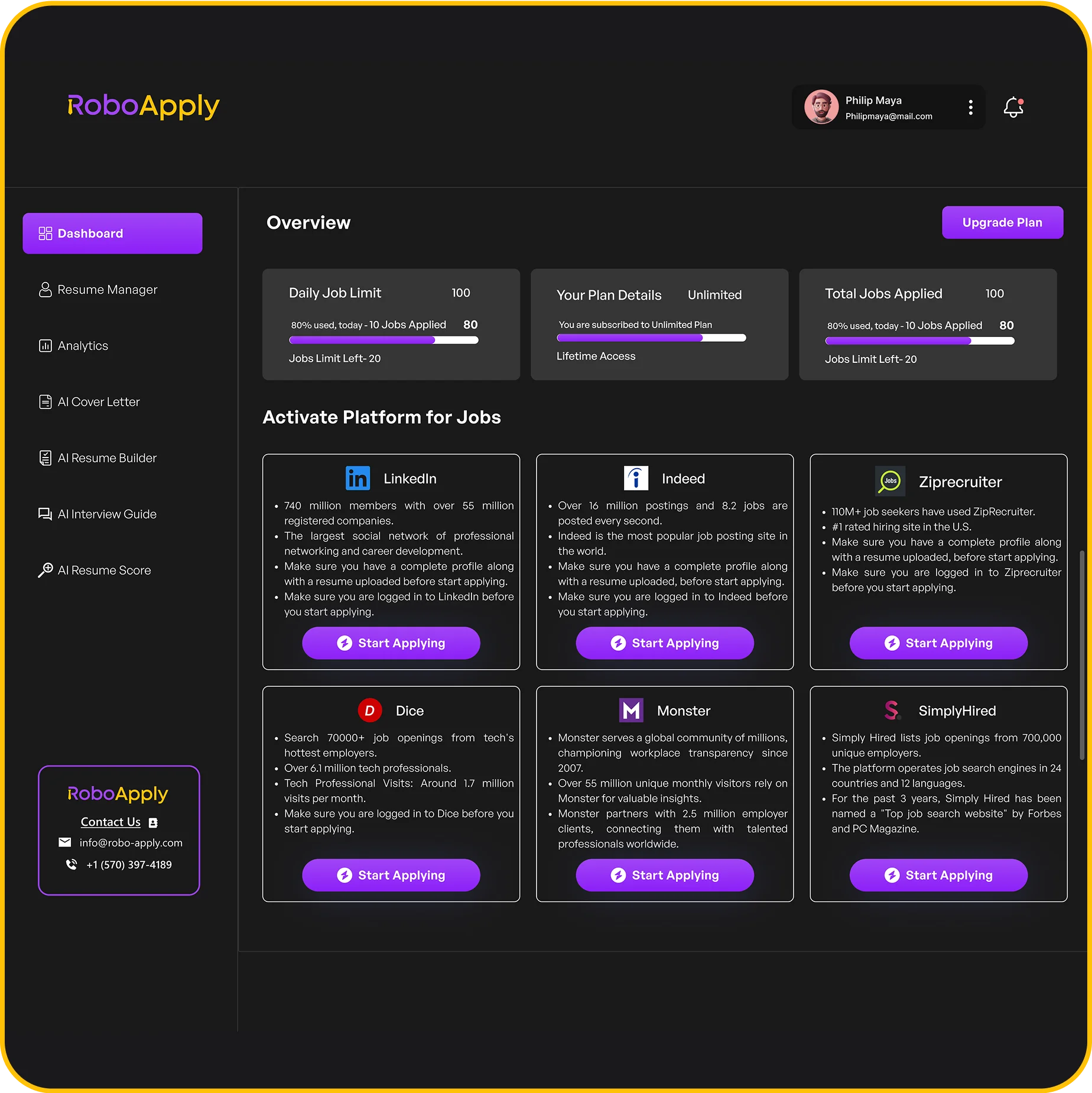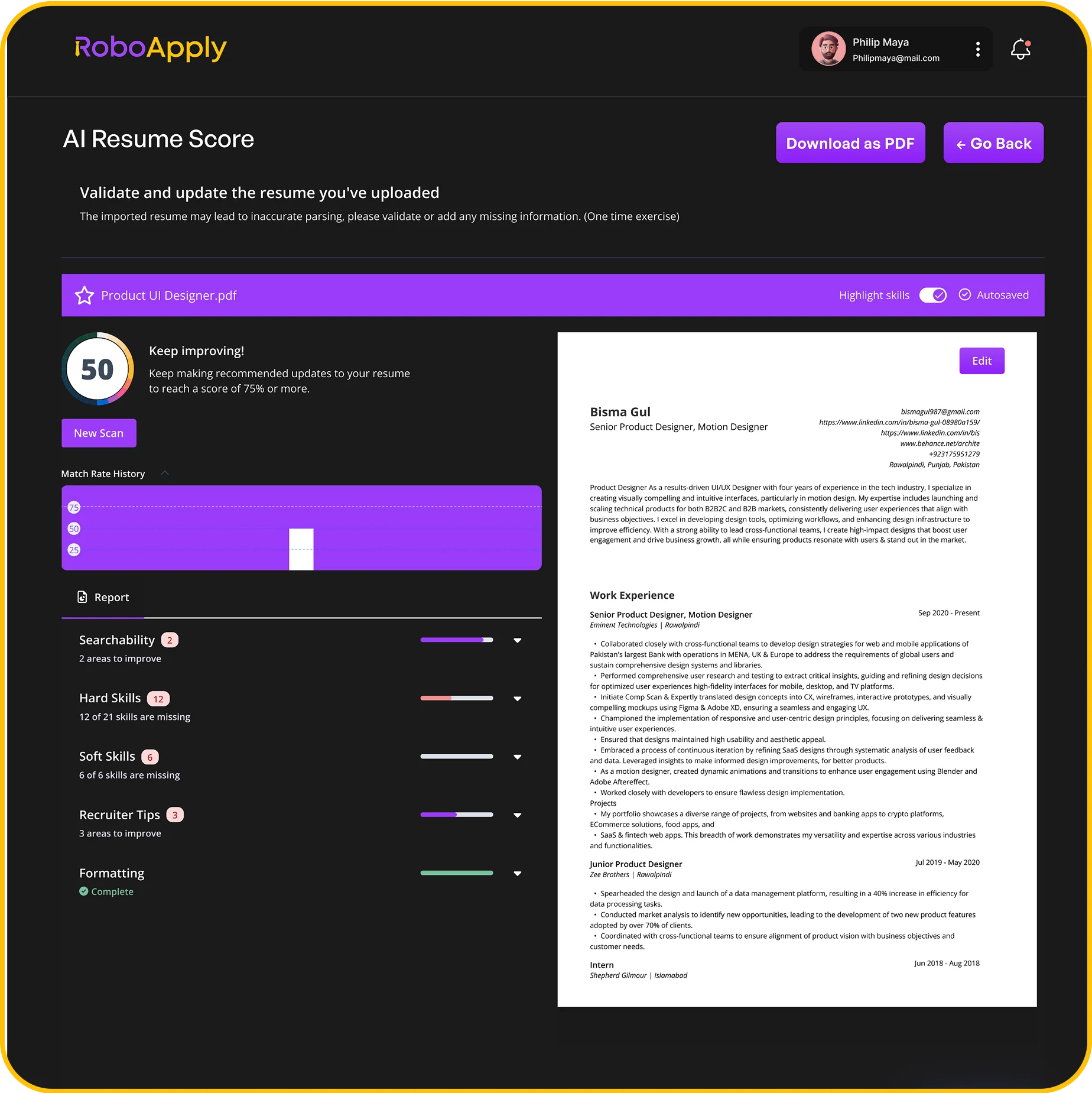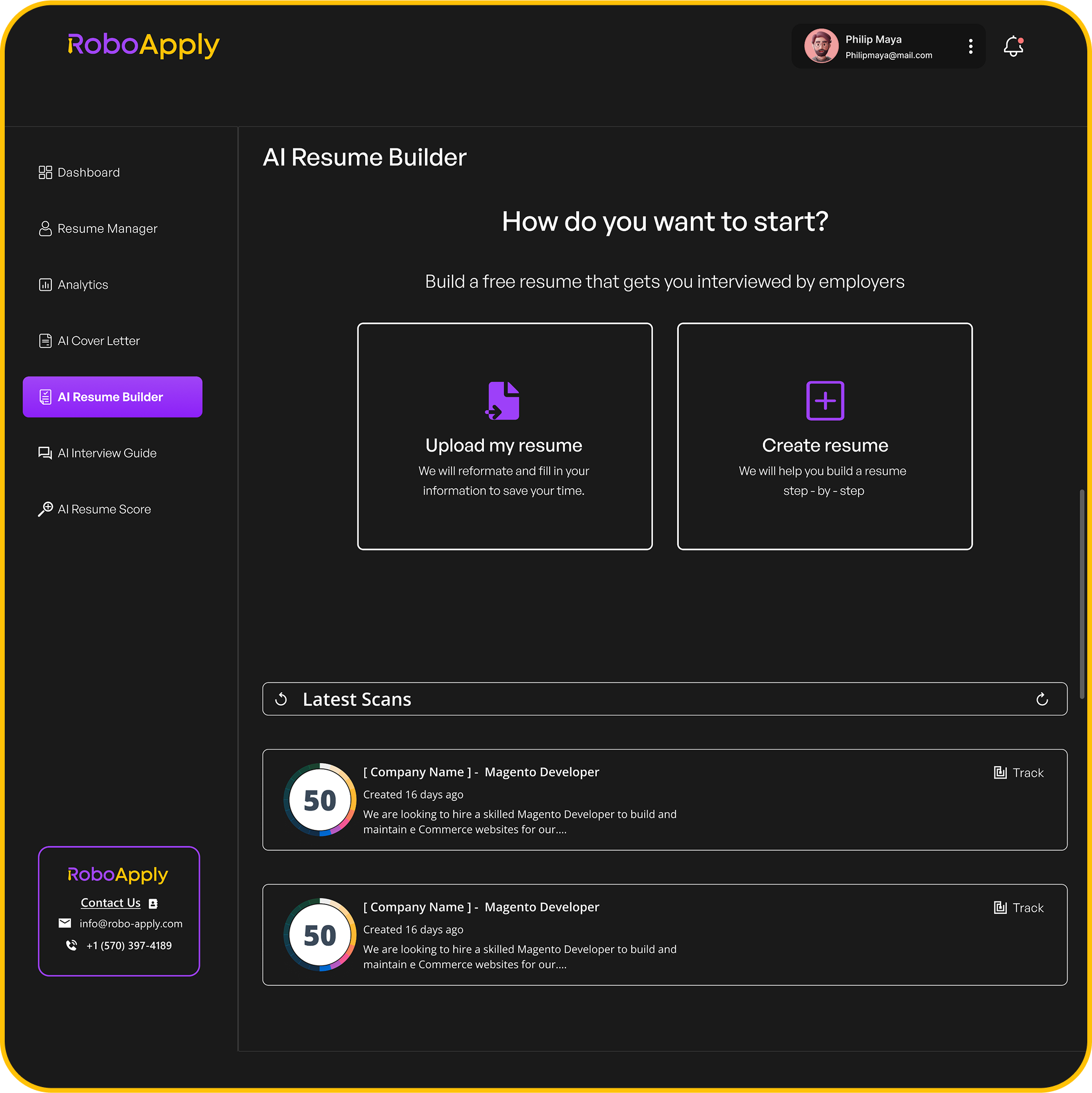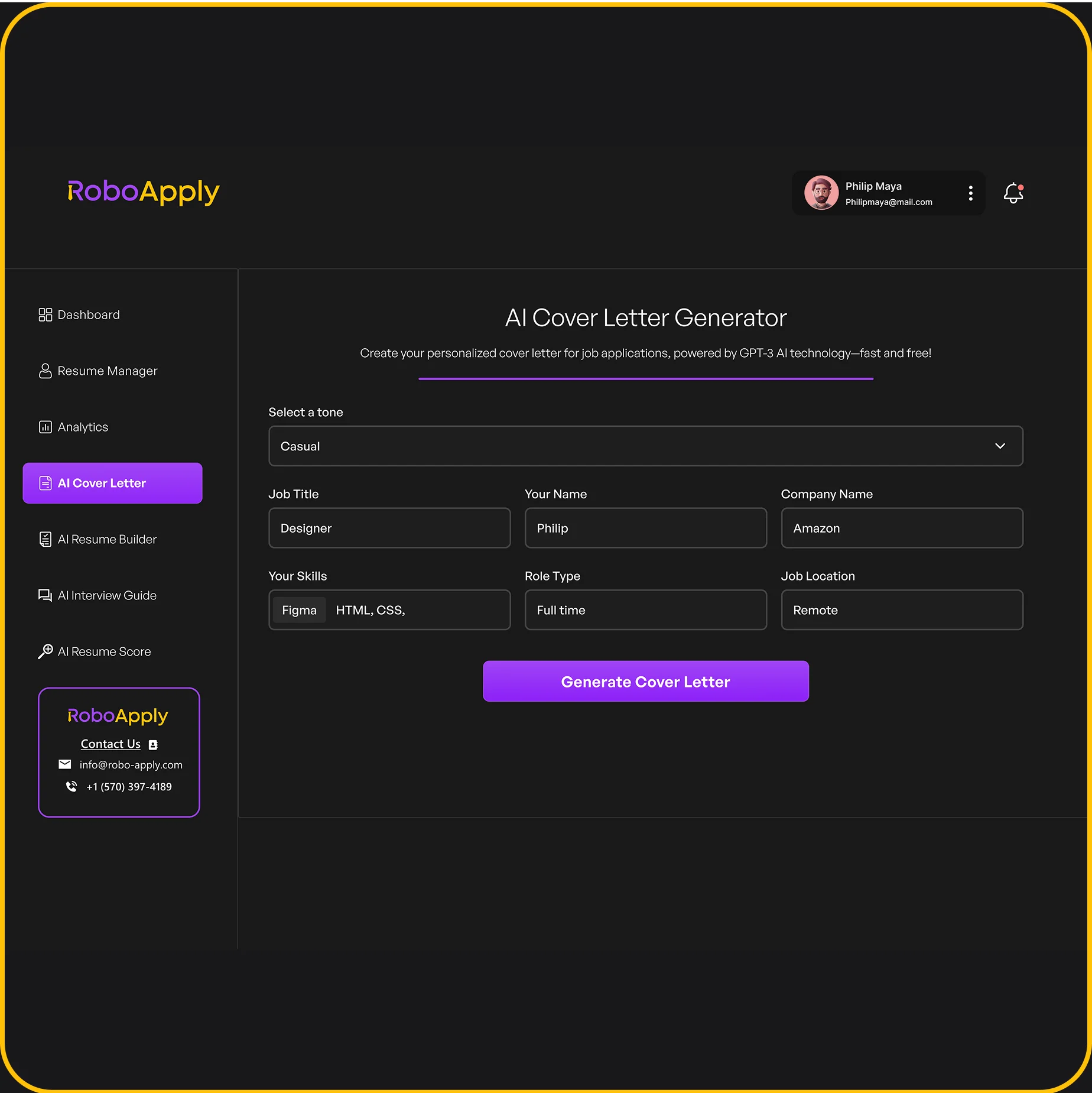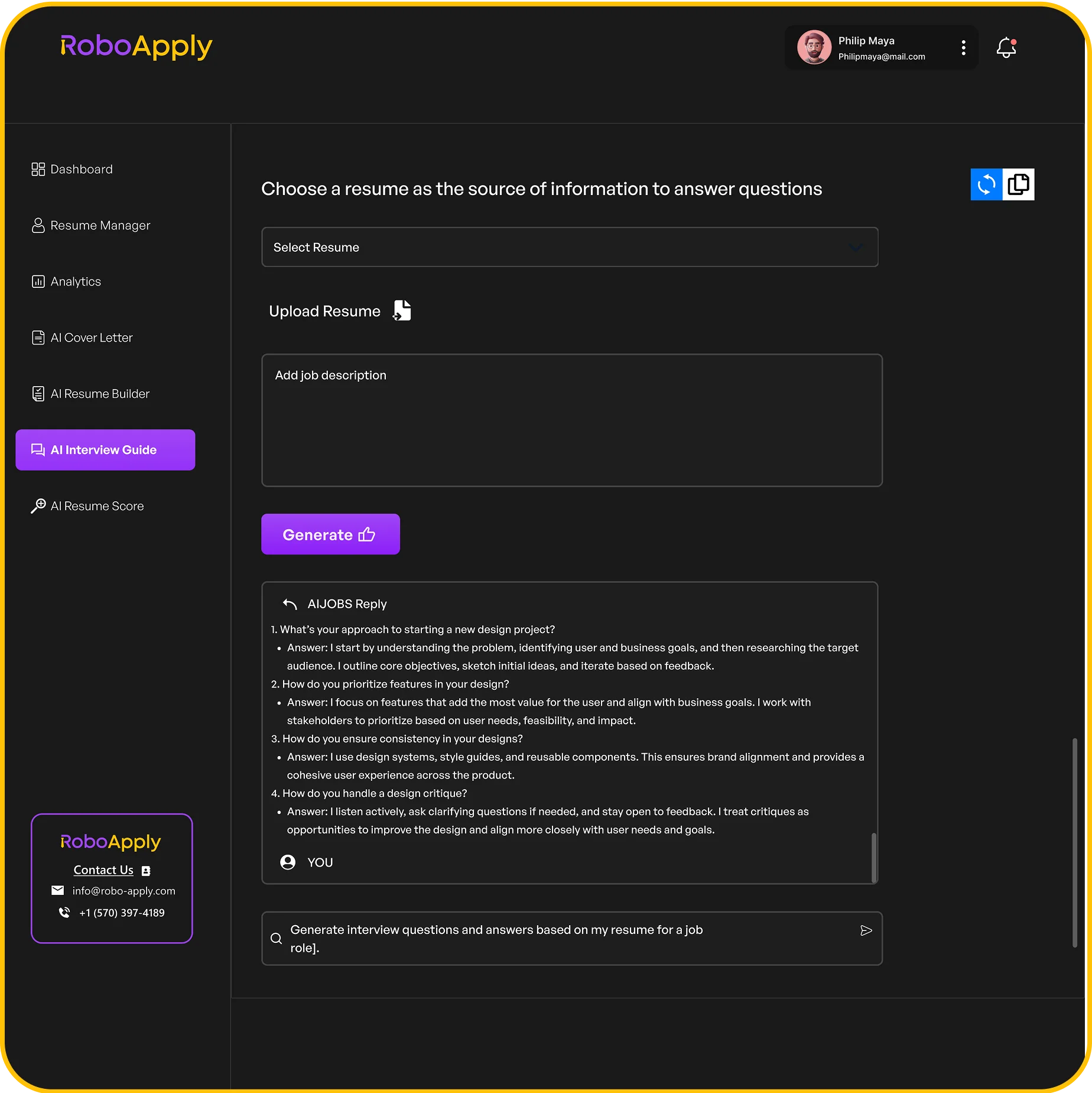1. Technical Support
Technical support roles are all about helping people with their tech problems. Your resume needs to show you’re good at troubleshooting, communicating, and keeping your cool under pressure. Let’s look at how to make your resume shine.
Entry-Level IT Resume Template for Technical Support
When crafting your resume, consider using a template specifically designed for technical support roles. These templates often highlight the skills and experiences that are most relevant to employers in the IT field. Using a template can save you time and ensure that your resume is well-organized and easy to read.
Entry-Level IT Resume Sample for Technical Support | Plain Text
Here’s an example of what a plain text resume might look like for an entry-level technical support role:
Sophia Allen
Boston, MAEmail: sophia.allen@gmail.com
Phone: (353) 153-3245
Objective
Detail-oriented and customer-focused Technical Support Specialist with hands-on experience in troubleshooting hardware and software issues. Eager to leverage communication and problem-solving skills to provide exceptional IT support.
Experience
Technical Support Intern
Tech Solutions Inc., Boston, MA
June 2024 – PresentAssist in diagnosing and resolving technical issues related to software, hardware, and networks for a diverse client base.
Manage and prioritize customer support tickets, ensuring timely resolution, follow-up, and documentation of all inquiries.
Provide remote assistance to users, troubleshooting issues related to applications, operating systems, and hardware over the phone and via chat.
Participate in software installations, updates, and configuration of new hardware to enhance company operations.IT Help Desk Assistant
Boston University, MA
September 2022 – May 2023Delivered first-line technical support for students, faculty, and staff, addressing issues with software, hardware, and network connectivity.
Documented and tracked user issues using the IT service management (ITSM) system, escalating complex technical problems to senior IT technicians.
Contributed to the development and maintenance of a comprehensive knowledge base to assist in troubleshooting and resolving common IT issues.Education
Bachelor of Science in Information Technology
University of Massachusetts, Boston, MA
Graduated: May 2024Capstone Project: Developed a ticket management system prototype designed to streamline IT support workflows and reduce response times.
Certifications
CompTIA A+
Certification Date: March 2023
Microsoft Certified: Windows Server Fundamentals
Certification Date: April 2023
SkillsTroubleshooting hardware and software issues (PCs, laptops, printers, etc.)
Basic networking knowledge (TCP/IP, DNS, DHCP, VPN)
Proficiency in Windows OS, Linux OS, and Mac OS
Remote desktop support (RDP, VNC)
Experience with Microsoft Office Suite and Google Workspace
Excellent verbal and written communication skills for customer supportLanguages
English: Native
Spanish: IntermediateAwards
Highlighting Key Skills
Make sure to showcase your technical skills prominently. This includes listing specific software, hardware, and operating systems you’re familiar with. Also, don’t forget to mention your problem-solving and communication abilities, as these are crucial in a technical support role. Consider adding a section for certifications like CompTIA A+ or Microsoft Certified Professional to boost your credibility. You can use entry-level software engineer resume examples to get an idea of how to present your skills effectively.
2. Junior Software Developer
So, you’re aiming for a Junior Software Developer role? Awesome! Your resume needs to show you’re ready to jump in and start contributing. Let’s break down how to make that happen.
Entry-Level Resume Example
Let’s look at an example. Imagine a candidate named Daniel Moore. Here’s how he might structure his resume:
Daniel Moore
San Diego, CA
daniel.moore@gmail.com
(555) 987-6543
Summary:
Motivated Junior Software Developer with a strong foundation in programming languages including Python, Java, and C++. Passionate about coding, debugging, and improving the performance of web applications. Eager to apply problem-solving skills and technical expertise in a collaborative development environment to create efficient and scalable software solutions.
Experience:
Junior Software Developer
Innovate Tech Solutions, San Diego, CA
July 2024 – Present
- Assist in the design, testing, and deployment of software applications for clients in diverse sectors, including healthcare and finance.
- Participate in code reviews and collaborated with senior developers to optimize software.
Skills to Highlight
Make sure to list both your technical and soft skills. Technical skills might include specific programming languages, frameworks, or tools. Soft skills could be things like teamwork, communication, and problem-solving. Tailor these to match the job description.
- Programming Languages: Python, Java, JavaScript, C++
- Frameworks/Libraries: React, Angular, Node.js
- Tools: Git, Docker, Jenkins
Projects are Key
Since you’re entry-level, you might not have tons of professional experience. That’s where personal projects come in. Did you build a website? Contribute to an open-source project? Showcase it! Describe what you did, the technologies you used, and what you learned. This is a great way to demonstrate your abilities.
Education Matters
List your degree, major, and any relevant coursework. If you have a high GPA, include it. Also, mention any relevant certifications or online courses you’ve completed. This shows you’re committed to learning and growing. Consider adding a cover letter to further showcase your enthusiasm.
Remember, your resume is your first impression. Make it count! Proofread carefully, use a clean and professional format, and tailor it to each job you apply for. Good luck!
Use Action Verbs
Instead of just listing your responsibilities, use action verbs to describe what you did. For example:
- Developed
- Implemented
- Designed
- Collaborated
- Optimized
These verbs make your resume more dynamic and show that you took initiative. You can also use a tool to optimize resumes to make sure you are using the right keywords.
Quantify Your Achievements
Whenever possible, quantify your achievements. Instead of saying "Improved website performance," say "Improved website performance by 15% by optimizing image loading times." Numbers make your accomplishments more concrete and impressive. Make sure your software engineer resume is tailored to the specific job description.
3. Cybersecurity Analyst
So, you want to break into cybersecurity? Awesome! It’s a field with tons of opportunity. Your resume needs to show you’re ready to protect systems and data. Let’s look at how to make that happen.
Skills to Highlight
When you’re gunning for an entry-level cybersecurity analyst position, you need to showcase the skills you’ve got. Employers want to see you have a mix of technical know-how and soft skills. Here’s a breakdown:
- Technical skills: Network security, intrusion detection, risk assessment, and knowledge of security tools (SIEM, firewalls, etc.).
- Problem-solving: Show how you can analyze security issues and come up with solutions.
- Communication: You need to explain technical stuff to non-technical people.
- Analytical skills: Being able to spot patterns and anomalies is key.
Experience Section
Even if you don’t have a ton of direct experience, you can still make this section shine. Think about internships, projects, or even volunteer work where you used relevant skills. For example:
- IT Support Technician
TechSafe Inc., Chicago, IL
*July 2022 – May 2023- Assisted in ensuring systems were up-to-date with the latest security patches for operating systems and software applications, reducing exposure to potential threats.
- Collaborated with the IT team to respond to security incidents, conducting post-incident analysis to prevent future occurrences.
- Provided training to employees on cybersecurity awareness, helping to decrease phishing incidents by 30%.
Education and Certifications
Your education is important, especially if you’re just starting out. List your degree, relevant coursework, and any certifications you’ve earned or are working towards. Certifications like CompTIA Security+ or Certified Ethical Hacker (CEH) can really boost your resume. For example:
- Bachelor of Science in Information Security
DePaul University, Chicago, IL
*Graduated: October 2024- Key Coursework: Network Security, Cryptography and Encryption, Ethical Hacking
Quantifiable Achievements
Whenever possible, use numbers to show the impact you’ve made. Did you reduce security incidents by a certain percentage? Did you improve system performance? Numbers grab attention and make your accomplishments more believable. For example, "Implemented a comprehensive threat detection strategy using AI and machine learning, resulting in a 30% reduction in undetected breaches within the first year."
Remember to tailor your resume to each job you apply for. Read the job description carefully and highlight the skills and experience that are most relevant. Use keywords from the job description throughout your resume to help it get past applicant tracking systems (ATS). Tailoring your entry-level cybersecurity resume will significantly increase your chances of landing an interview.
Example Snippets
Here are a few snippets you can adapt for your resume:
- "Monitored network traffic and identified potential security threats, escalating issues to the team to focus on strategic defenses."
- "Researched and resolved security breaches in close collaboration with the senior analyst team, contributing to a 10% decline in security incidents year over year."
- "Provided actionable recommendations for strengthening network defenses, contributing to a 20% increase in overall security posture."
4. Programmer
As a programmer, your resume needs to highlight your coding skills and problem-solving abilities. Let’s look at how to make your resume stand out.
Skills Section
Your skills section is prime real estate. Make sure it’s easy to read and lists both your technical and soft skills. Here’s how you can structure it:
- Programming Languages: Python, Java, C++, JavaScript, Go, etc. List your proficiency level (e.g., proficient, intermediate, basic) next to each.
- Frameworks/Libraries: React, Angular, Node.js, Spring, .NET, etc. Again, specify your experience level.
- Databases: SQL, NoSQL (MongoDB, Cassandra), MySQL, PostgreSQL. Mention any experience with database design and management.
- Tools: Git, Docker, Kubernetes, Jenkins, AWS, Azure, etc. Include any experience with version control, containerization, or cloud platforms.
Projects Section
This is where you show, not just tell. Describe projects where you’ve used your programming skills. For each project:
- Project Name: Give it a clear and descriptive name.
- Brief Description: Summarize the project’s purpose and your role.
- Technologies Used: List the programming languages, frameworks, and tools you used.
- Key Accomplishments: Highlight specific achievements, such as solving a critical bug or improving performance. For example, "Solved a critical software bug during an internship, which improved application stability by 15%."
Education Section
List your degrees, certifications, and relevant coursework. If you have a degree in computer science or a related field, put it at the top. Include any relevant certifications, such as:
- CompTIA A+
- Microsoft Certified Professional (MCP)
- AWS Certified Developer
Experience Section
Even if you don’t have a ton of professional experience, you can still make this section shine. Focus on internships, volunteer work, or personal projects. For each experience:
- Job Title: Be specific (e.g., Software Development Intern, Volunteer Programmer).
- Company/Organization: Name of the company or organization.
- Dates of Employment: Start and end dates.
- Responsibilities: Use action verbs to describe your tasks and accomplishments. Quantify your results whenever possible. For example, "Developed a web application using React and Node.js that increased user engagement by 20%."
Remember to tailor your resume to the specific job you’re applying for. Highlight the skills and experiences that are most relevant to the position. A well-crafted programmer resume software engineer resume examples can open doors to exciting opportunities.
5. System Administrator
Landing a system administrator role straight out of the gate? It’s doable! Your resume needs to show you’re ready to keep things running smoothly. Think of it as your chance to prove you can handle the tech behind the scenes.
Skills to Highlight
- Operating Systems: Windows Server, Linux (various distributions), macOS.
- Scripting: PowerShell, Python, Bash.
- Networking: TCP/IP, DNS, DHCP, VPN.
- Virtualization: VMware, Hyper-V.
- Cloud Platforms: AWS, Azure, Google Cloud.
- Automation Tools: Ansible, Chef, Puppet.
- Monitoring Tools: Nagios, Zabbix, Prometheus.
Example Snippets
- "Automated server patching process using PowerShell, reducing downtime by 20%."
- "Managed user accounts and permissions in Active Directory."
- "Configured and maintained network infrastructure, including routers, switches, and firewalls."
- "Implemented monitoring solutions to proactively identify and resolve system issues."
- "Provided technical support to end-users, resolving hardware and software issues."
Quantifiable Achievements
Numbers speak volumes. Instead of just saying you "improved system performance," try something like this: "Improved system performance by 15% through server optimization and resource allocation." Or, "Reduced help desk tickets by 25% by creating automated solutions for common user issues." These metrics show the impact of your work. For example, this System Administrator resume example shows proficiency in automating IT processes with Python and PowerShell, leading to a 30% reduction in system workload.
Projects to Showcase
- Home Lab Setup: Describe your home lab, including the hardware and software you used, and the projects you completed.
- Scripting Projects: Share scripts you’ve written to automate tasks, such as user account creation or system monitoring.
- Network Configuration: Detail any network configurations you’ve done, such as setting up a VPN or configuring a firewall.
- Cloud Deployments: Describe any cloud deployments you’ve done, such as deploying a web application on AWS or Azure.
Remember to tailor your resume to each job application. Highlight the skills and experiences that are most relevant to the specific position. Research the company and the role to understand their needs and show how you can meet them.
Education and Certifications
List your degree (Computer Science, Information Technology, or related field). Include relevant certifications like CompTIA A+, Network+, Security+, or Microsoft Certified: Azure Administrator Associate. Don’t underestimate the power of a well-placed certification to show you’re serious about the field. If you are applying for a security guard position, make sure to highlight your key skills in the resume.
6. Data Scientist
As a data scientist, your resume needs to show you can wrangle data, build models, and tell a story with your findings. It’s not just about knowing the tools; it’s about showing how you’ve used them to solve problems. Let’s look at how to make your resume shine.
Skills
Listing your skills is important, but don’t just throw out a bunch of keywords. Group them logically and show your proficiency. For example:
- Data Analysis: SQL, Python (Pandas, NumPy), R, Tableau, Power BI, Excel Macros
- Databases: MySQL, PostgreSQL, MongoDB, Hadoop, Oracle DB
- Data Mining Tools: WEKA, KNIME, RapidMiner, SAS, SPSS Modeler
- Development: Java, C++, Git, Jenkins, Docker, Kubernetes
Experience
When describing your experience, focus on the impact you made. Use numbers to quantify your achievements whenever possible. For example, instead of saying "Improved data insights," say "Improved accuracy of insights derived from data by 25%."
Here’s an example:
Google March 2015 – September 2018
IT Data Analyst
- Utilized data mining techniques.
- Developed and implemented a new data classification strategy that improved accuracy of insights derived from data by 25%.
- Designed new data models and predictive algorithms, increasing business decision accuracy by 35%.
Education
List your degrees, but also highlight relevant coursework or projects. If you have a senior thesis related to data science, definitely include it.
For example:
Resume Worded Institute May 2012
Bachelor of Science in Computer Science
- Cum Laude
- Senior Thesis on Predictive Analytics in IT environments
Projects
Personal projects are a great way to show your skills, especially if you don’t have much work experience. Describe the problem you were trying to solve, the tools you used, and the results you achieved. If you’re looking for resume templates, there are many free options available online.
Certifications
Listing certifications can help demonstrate your knowledge and commitment to the field. Some relevant certifications include:
- Certified Data Management Professional (CDMP)
- CompTIA Security+
Remember to tailor your resume to each job you apply for. Highlight the skills and experiences that are most relevant to the specific position. Use tools like RoboApply to help you customize your resume and apply to jobs more efficiently. Also, make sure to include an IT cover letter to show your interest in the position.
7. Software Engineer
As a software engineer, your resume needs to show you can actually build things. It’s not just about knowing the theory; it’s about proving you can turn ideas into reality. Let’s look at how to make your resume stand out.
Here’s what a software engineer resume might include:
- Contact Information: Your name, phone number, email, and LinkedIn profile.
- Summary/Objective: A brief overview of your skills and career goals. This is your chance to make a first impression.
- Skills: List both technical skills (programming languages, frameworks, tools) and soft skills (communication, teamwork).
- Projects: Showcase personal or academic projects that demonstrate your coding abilities. Include details about your role, technologies used, and outcomes.
- Experience: Detail any relevant work experience, internships, or volunteer positions. Focus on your contributions and achievements.
- Education: List your degrees, certifications, and relevant coursework.
Remember to tailor your resume to each job application. Highlight the skills and experiences that are most relevant to the specific role.
Here’s an example of how you might structure your experience section:
Software Development Intern
TechStart Inc., San Diego, CA
May – July 2023
- Collaborated with a team of developers on the creation of a customer management system using C++ and MySQL.
- Wrote unit tests and automated build scripts, improving the efficiency and reliability of the development workflow.
- Assisted in the deployment of applications to cloud servers (AWS), ensuring smooth operation and minimal downtime.
- Participated in daily stand-ups, sprint planning, and other Agile ceremonies to ensure timely delivery of tasks.
And here’s an example of how you might structure your education section:
Bachelor of Science in Computer Science
University of California, San Diego, CA
Graduated: May 2024
When listing your skills, be specific. Instead of just saying "programming," list the specific languages you know, like Java, C#, JavaScript, Python, and SQL. Also, include any test automation tools you’re familiar with, such as Selenium WebDriver and TestNG. This helps recruiters quickly identify if you have the skills they’re looking for. Make sure to include a professional summary example to highlight your key qualifications.
Consider adding a section for certifications, especially if you have industry-recognized credentials like Certified Software Test Engineer (CSTE). This shows you’re committed to professional development. You can also include details about any workshops or hackathons you’ve participated in. These activities demonstrate your passion for software engineering and your willingness to learn new things. Remember to tailor your entry-level software engineer resume to match the job description.
8. Computer Science
Landing an entry-level IT job with a computer science degree is totally doable. Your resume just needs to highlight the right stuff. Think about it: employers want to see you can actually do the things you learned in school. Let’s break down how to make that happen.
Education
Okay, so you’ve got a degree. Great! But how do you make it shine on your resume? List your degree prominently, of course, but don’t stop there. Include relevant coursework. Did you ace Data Structures? Did you build a killer project in your Web Development class? List it! This shows employers you’ve got the foundational knowledge. For example:
- Bachelor of Science in Computer Science
- University of Example, Exampleville, CA
- Graduated: May 2024
- Relevant Coursework: Data Structures and Algorithms, Database Management, Software Engineering, Operating Systems
Skills
This is where you show off what you can actually do. Don’t just list languages; show how you’ve used them. Did you build a web app with React? Did you automate tasks with Python? List those specific applications. Here’s a breakdown:
- Programming Languages: Python, Java, C++, JavaScript
- Web Development: HTML, CSS, React, Node.js
- Databases: MySQL, PostgreSQL, MongoDB
- Cloud: AWS, Azure, Google Cloud
- Tools: Git, Docker, Kubernetes
Projects
Projects are HUGE. They’re proof you can take what you learned and apply it to real-world problems. Even if it’s a small project, detail what you did, what technologies you used, and what you learned. Did you contribute to an open-source project? Even better! Make sure to include a link to the project on GitHub if you can. For example:
- Personal Website: Developed a responsive personal website using React, showcasing my skills and projects.
- Data Analysis Project: Analyzed a dataset of customer reviews using Python and Pandas to identify key trends and insights.
Certifications
Certifications show you’re serious about learning and staying up-to-date. They also validate your skills in specific areas. If you’ve got any relevant certs, list them! CompTIA, AWS, Azure, Google Cloud – all good options. Make sure to include the certification name, the issuing organization, and the date you earned it. This shows you’re committed to professional development.
- AWS Certified Cloud Practitioner
- CompTIA A+
- Microsoft Certified: Azure Fundamentals
Remember, your resume is your sales pitch. Tailor it to each job you apply for. Highlight the skills and experiences that are most relevant to the specific role. Don’t just list everything you’ve ever done; focus on what makes you a good fit for this job.
9. IT Professional
Creating a resume as an IT professional means showing you’re not just tech-savvy, but also a problem-solver and a team player. It’s about highlighting your experience in a way that speaks directly to what employers are looking for. Let’s get into how to make your resume stand out.
First off, think about what the job description is asking for. Tailor your resume to match those specific needs. It’s not enough to just list your skills; you need to show how you’ve used them to achieve results. Think about projects you’ve worked on, problems you’ve solved, and how you’ve contributed to the team’s success. This approach helps to build a strong IT resume.
Here are some tips to consider:
- Quantify your achievements. Instead of saying you "improved network performance," say you "improved network performance by 15%." Numbers speak volumes.
- Use action verbs. Start your bullet points with strong action verbs like "implemented," "managed," "developed," or "resolved."
- Keep it concise. Recruiters often spend just a few seconds reviewing a resume, so make sure your points are clear and to the point.
Remember, your resume is your first impression. Make it count by showcasing your skills, experience, and achievements in a way that’s easy to read and relevant to the job you’re applying for.
Also, don’t forget to highlight any relevant certifications you have. Certifications like CompTIA A+, Network+, or Security+ can really boost your credibility. Make sure they’re easy to find on your resume. If you’re just starting out, focus on your education and any personal projects you’ve worked on. Even if it’s not professional experience, it shows you’re passionate and willing to learn. Highlighting acquired skills like technical expertise is key.
Finally, proofread, proofread, proofread! Nothing says "unprofessional" like a resume full of typos. Have a friend or family member look it over before you send it out. A polished resume shows you pay attention to detail, which is a valuable trait in any IT professional.
10. IT Cover Letter
An IT cover letter is your chance to shine beyond your resume. It’s where you show your personality, explain why you’re a great fit for the company, and highlight specific achievements. Think of it as your sales pitch – but in writing.
Tailoring Your Cover Letter
Generic cover letters are a no-go. You need to customize each one for the specific job you’re applying for. Research the company, understand their values, and show how your skills and experience align with their needs. It shows you’ve put in the effort and genuinely care about the position. For example, if they value innovation, talk about a time you implemented a new technology that improved efficiency. This is how you write a compelling cover letter.
Showcasing Your Achievements
Don’t just list your skills; demonstrate them with concrete examples. Use the STAR method (Situation, Task, Action, Result) to describe how you tackled challenges and achieved positive outcomes. Did you reduce help desk tickets by 15%? Did you successfully migrate a company’s data to a new system? Quantify your achievements whenever possible to make them more impactful. This is especially important when you describe your specific knowledge.
Maintaining Clarity and Conciseness
Keep your cover letter brief and to the point. Aim for a single page and use clear, concise language. Avoid jargon and technical terms that the hiring manager might not understand. Focus on the most relevant information and make it easy for them to see why you’re the best candidate. Remember, they’re likely reading dozens of these, so make yours stand out by being clear and easy to read.
A well-written cover letter can significantly increase your chances of landing an interview. It’s your opportunity to make a strong first impression and show the hiring manager why you’re the right person for the job.
Example Snippet
Here’s a short example of how to frame your experience:
"During my internship at Tech Solutions Inc., I was responsible for troubleshooting network issues. I implemented a new monitoring system that reduced downtime by 20% and improved overall network performance."
11. Resume Objective
Okay, so the resume objective. It’s that little blurb at the top of your resume, right under your contact info. Some people say it’s outdated, but for entry-level IT jobs? It can be your secret weapon. Think of it as your elevator pitch in text form. You’ve got a few seconds to grab their attention and show them why they should keep reading. Let’s get into it.
The resume objective is a concise statement highlighting your career aspirations and relevant skills. It’s especially useful if you’re light on experience, like most entry-level candidates. It tells the hiring manager what you’re aiming for and what you bring to the table, even without years of experience under your belt.
Here’s the deal:
- Keep it short and sweet: Aim for 2-3 sentences max. No one wants to read a novel.
- Focus on them, not you: It’s not about what you want; it’s about what you can do for the company.
- Tailor it to the job: Generic objectives are a waste of space. Read the job description and tweak your objective to match.
- Highlight relevant skills: Even if they’re from school projects or personal projects, show them what you’ve got.
A good resume objective shows you’ve thought about your career path and how this specific role fits into it. It’s a quick way to demonstrate your enthusiasm and potential.
Let’s look at an example. Imagine you’re applying for a junior help desk position:
Good Example:
"Enthusiastic and quick-learning IT graduate seeking a Junior Help Desk position at Tech Solutions Inc. Eager to apply strong troubleshooting skills and customer service experience gained through academic projects and a part-time tech support role to provide efficient technical assistance and contribute to a positive user experience."
See how it’s specific, highlights skills, and shows enthusiasm? Now, let’s look at what not to do.
Bad Example:
"I want a job in IT where I can learn and grow."
Yeah, that’s not gonna cut it. It’s all about you, and it doesn’t say anything specific. It’s like saying you want to breathe air – duh!
Here are some extra tips to make your resume objective shine:
- Quantify your achievements: If possible, use numbers to show your impact. For example, "Resolved an average of 15 support tickets per day…"
- Use keywords from the job description: This helps your resume get past applicant tracking systems (ATS).
- Proofread, proofread, proofread: Typos are a major turn-off.
And here’s a table to illustrate the difference between a good and bad objective:
| Feature | Good Objective be specific about your IT role you’re applying for.
So, go forth and write an awesome resume objective! You got this!
12. Projects
Projects are a fantastic way to show off what you can do, especially when you’re just starting out and don’t have a ton of work experience. They let you demonstrate your skills and passion in a tangible way. Think of them as your chance to shine and show potential employers what you’re capable of bringing to the table. Let’s look at some ideas.
Including projects on your resume can significantly boost your chances of landing an interview.
- Personal Website/Portfolio: A personal website is a great way to showcase your skills and projects. It’s like your own little corner of the internet where you can highlight your work and personality. Use it to display your coding projects, design work, or anything else you’re proud of. It shows you know web development and are serious about your career.
- Mobile App Development: Creating a mobile app, even a simple one, demonstrates your coding abilities and problem-solving skills. It could be a to-do list app, a simple game, or something that solves a specific problem you’ve identified. The key is to show you can take an idea from concept to completion. Check out these programming side projects for inspiration.
- Data Analysis Project: If you’re interested in data science, a data analysis project is a must. Find a dataset online (there are tons of free ones available) and use your skills to analyze it and draw insights. Present your findings in a clear and compelling way. This shows you can work with data and communicate your results effectively.
Projects don’t have to be huge or complex. The most important thing is that they demonstrate your skills and passion. Choose projects that align with your career goals and that you’re genuinely interested in. This will make the process more enjoyable and the end result more impressive.
- Network Security Optimization: Showcasing a project where you optimized network security measures can be very impressive, especially if you’re aiming for cybersecurity roles. Describe the steps you took to identify vulnerabilities, implement security protocols, and improve overall network resilience. Quantify the impact of your work whenever possible.
- Automation Script: Write a script that automates a repetitive task. This could be anything from automating file management to creating a script that sends out automated emails. This shows you understand scripting and can use it to improve efficiency.
- Open Source Contributions: Contributing to open source projects is a fantastic way to gain experience and show your skills. Find a project you’re interested in and start contributing. This demonstrates your ability to work in a team and your commitment to the open-source community.
13. Workshops
Workshops are a fantastic way to gain practical skills and demonstrate your commitment to continuous learning. They show potential employers that you’re proactive and eager to expand your knowledge base. Plus, they can give you a leg up when you’re competing with other entry-level candidates.
Example Workshop Entry
Here’s how you might list a workshop on your resume:
- Workshop Name: Introduction to Cloud Computing with AWS
- Organization: Amazon Web Services
- Date: May 2025
- Key Skills Learned:
- Basic cloud concepts
- AWS services (EC2, S3)
- Cloud deployment strategies
Why Workshops Matter
Workshops provide focused, hands-on experience that can be directly applied to real-world scenarios. They’re often shorter and more intensive than traditional courses, making them a great way to quickly acquire new skills. Think of them as mini-bootcamps that can significantly boost your IT resume.
Workshops can also be a great networking opportunity. You’ll meet other professionals in your field, which can lead to valuable connections and potential job opportunities.
Types of Workshops to Consider
- Coding Workshops: Focus on specific programming languages or frameworks (e.g., Python, JavaScript, React).
- Cybersecurity Workshops: Cover topics like ethical hacking, network security, and incident response.
- Data Science Workshops: Explore data analysis, machine learning, and data visualization techniques.
- Cloud Computing Workshops: Introduce cloud platforms like AWS, Azure, or Google Cloud.
- Project Management Workshops: Teach you the basics of project planning, execution, and monitoring.
Tips for Listing Workshops
- Be Specific: Don’t just say you attended a "coding workshop." Specify the language or technology covered.
- Highlight Key Skills: List the most relevant skills you gained during the workshop. Use action verbs to describe what you learned (e.g., "Implemented," "Designed," "Analyzed").
- Quantify Your Achievements: If possible, quantify your accomplishments. For example, "Developed a web application using React during the workshop."
Free IT Certificate Programs
Don’t forget to explore free IT certificate programs that often include workshop-style components. These can be a great way to gain valuable skills and certifications without breaking the bank. Look for programs offered by reputable organizations like Google or Microsoft.
14. Internships
Internships are gold on an entry-level IT resume. They show you’ve got some real-world experience, even if it’s just a taste. They bridge the gap between classroom learning and actual job duties. Let’s look at how to present them.
Here’s the thing: you want to highlight what you did and what you learned. Don’t just list tasks; show how you contributed.
Internships are a great way to show potential employers that you have the skills and experience necessary to succeed in the role. Make sure to highlight your accomplishments and quantify your results whenever possible.
Here’s an example:
Technical Support Intern
Tech Solutions Inc., Boston, MA
June 2024 – Present
- Assisted in diagnosing and resolving technical issues related to software, hardware, and networks for a diverse client base.
- Managed and prioritized customer support tickets, ensuring timely resolution, follow-up, and documentation of all inquiries.
- Provided remote assistance to users, troubleshooting issues related to applications, operating systems, and hardware over the phone and via chat.
- Participated in software installations, updates, and configuration of new hardware to enhance company operations.
IT Help Desk Assistant
Boston University, MA
September 2022 – May 2023
- Delivered first-line technical support for students, faculty, and staff, addressing issues with software, hardware, and network connectivity.
- Documented and tracked user issues using the IT service management (ITSM) system, escalating complex technical problems to senior IT technicians.
- Contributed to the development and maintenance of a comprehensive knowledge base to assist in troubleshooting and resolving common IT issues.
Another example:
Software Development Intern
TechStart Inc., San Diego, CA
May – July 2023
- Collaborated with a team of developers on the creation of a customer management system using C++ and MySQL.
- Wrote unit tests and automated build scripts, improving the efficiency and reliability of the development workflow.
- Assisted in the deployment of applications to cloud servers (AWS), ensuring smooth operation and minimal downtime.
- Participated in daily stand-ups, sprint planning, and other Agile ceremonies to ensure timely delivery of tasks.
When describing your internship, consider these points:
- Quantify your achievements: Instead of saying "Improved software stability," say "Debugged application issues, leading to a 15% reduction in reported bugs."
- Use action verbs: Start each bullet point with a strong action verb like "Developed," "Implemented," or "Managed."
- Tailor to the job: Make sure the skills and experiences you highlight are relevant to the job you’re applying for. Use cover letter templates to help you tailor your resume.
- Show adaptability: Mention if you quickly learned new software or technologies during your internship. This shows you’re a fast learner. For example, "Demonstrated adaptability by quickly learning new software at both internships, leading to a 30% faster task completion rate."
Remember to include the company name, your job title, and the dates of your internship. This gives context to your experience. If you’re looking for engineering intern resume examples, there are many resources available online.
15. Certificates
Certifications can really boost your entry-level IT resume. They show employers you’ve got the skills and knowledge they’re looking for, and that you’re serious about your career. Think of them as a way to prove you know your stuff, even without tons of work experience. They give you an edge over other candidates.
Certifications are an objective measure of your technical abilities. They demonstrate your commitment to learning and staying current in the IT field.
Here are a few certifications that can make your resume stand out:
- CompTIA A+: This is a great starting point, covering a wide range of IT skills. It shows you have a solid foundation in hardware, software, and networking. It’s like the baseline for many IT jobs.
- CompTIA Security+: If you’re interested in cybersecurity, this is a good one to have. It covers security concepts and practices, showing you understand how to protect systems and data. It’s a solid choice for entry-level cybersecurity roles.
- Cisco Certified Network Associate (CCNA): If networking is your thing, the CCNA is a well-respected certification. It shows you know how to configure, manage, and troubleshoot networks. It’s a good way to show you’re serious about networking.
- Microsoft Certified: Azure Fundamentals: Cloud computing is huge, and this certification shows you understand the basics of Microsoft’s Azure cloud platform. It’s a good way to get your foot in the door with cloud-related jobs. Consider using ResumeBuilder.com to highlight this certification effectively.
- ITIL 4 Foundation: This certification focuses on IT service management. It shows you understand how to deliver IT services effectively and efficiently. It’s a good choice if you’re interested in IT management or support roles.
Listing your certifications correctly is important. Include the full name of the certification, the issuing organization, and the date you earned it. If the certification expires, include the expiration date as well. This shows employers you’re up-to-date on your skills.
16. Volunteering Experience
Volunteering can really make your resume stand out, especially if you’re just starting out in IT. It shows you’re willing to learn, you’re proactive, and you have a good work ethic. Plus, it can help you gain practical experience even if you don’t have a formal job yet. Here’s how to make the most of it on your resume.
Volunteering demonstrates initiative and a willingness to contribute, which are highly valued by employers, especially when you’re trying to break into the IT field.
Here’s an example of how you might list your volunteering experience:
- Volunteer IT Support, Local Library (Summer 2024)
- Tech Assistant, Senior Center (Fall 2023)
- Web Design Volunteer, Non-Profit Organization (Spring 2023)
When describing your volunteer roles, focus on the skills you used and the impact you made. Did you improve efficiency? Did you help more people access technology? Quantify your achievements whenever possible. For example, instead of saying "Helped with website redesign," say "Helped redesign the organization’s website, resulting in a 20% increase in user engagement."
Don’t forget to tailor your volunteering experience to the specific IT job you’re applying for. If the job requires strong troubleshooting skills, highlight your experience resolving technical issues. If it requires web development skills, emphasize your web design projects. A well-crafted volunteering section can significantly boost your entry-level IT resume and show potential employers that you’re ready to contribute to their team. Also, remember to write a compelling volunteer cover letter to showcase your passion.
Giving back to your community is a great way to make a difference. It also helps you learn new things and meet cool people. If you’re looking for ways to help out, check out our website for some awesome ideas and opportunities!
Wrapping Things Up
So, there you have it. Getting your first IT job can feel like a big deal, but with a solid resume, you’re already way ahead. Remember, it’s all about showing what you can do, even if you don’t have years of experience. Focus on your skills, any projects you’ve worked on, and definitely show off your eagerness to learn. Keep it clear, keep it simple, and make sure it really shows who you are and what you’re aiming for. Good luck out there!
Frequently Asked Questions
What should I put on my resume for my first IT job?
For a first IT job, focus on showing you’re eager to learn and ready to work hard. Make sure to list any computer classes you’ve taken, even if they were just online. Talk about any projects you’ve done, even small ones, that show you can solve problems or build things with technology. Also, mention any customer service experience, as helping people is a big part of many IT roles.
How do I write an IT resume with no experience?
When you’re just starting out, it’s okay if you don’t have a lot of work experience. Instead, highlight your skills. Think about things like knowing how to use different computer programs, fixing simple tech issues, or even just being good at figuring things out. Also, include any school projects, volunteer work, or personal projects that show off your tech abilities.
How long should an entry-level IT resume be?
The best length for a first IT resume is usually one page. Recruiters look at many resumes quickly, so keeping it short and to the point helps them see your best qualities right away. Only include the most important and useful information.
What makes an entry-level IT resume stand out?
To make your entry-level IT resume stand out, use action words to describe what you’ve done. For example, instead of saying “helped customers,” say “resolved customer tech problems.” Also, try to use numbers when you can, like “improved system speed by 15%.” Show how you can learn new things quickly and how you’re excited about technology.
Should I include a resume objective or summary?
Yes, it’s a good idea to include a resume objective or summary at the top of your resume. This is a short paragraph that tells the hiring manager what kind of job you’re looking for and what you can bring to the team. For an entry-level role, it’s a great place to show your passion for IT and your career goals.
What are the most important skills for an entry-level IT resume?
For entry-level IT jobs, important skills include problem-solving, being able to communicate clearly, and a willingness to learn. Technical skills like knowing about operating systems (like Windows or Mac), basic networking, and common software applications are also very useful. If you know any coding languages, that’s a plus too.
How can I show my skills if I don’t have much work experience?
If you don’t have formal work experience, you can still show off your abilities. Include school projects, personal projects (like building a computer or a simple website), volunteer work, or any online courses and certifications you’ve completed. These all show that you have practical skills and are dedicated to learning.
Are IT certifications important for an entry-level resume?
Yes, certifications can really help your entry-level IT resume. They show that you’ve learned specific skills and are serious about an IT career. Popular ones include CompTIA A+, Network+, or Security+. Even free online courses with completion certificates can be helpful to include.











